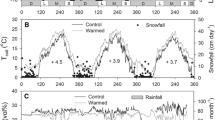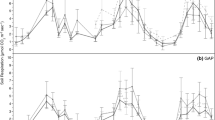Abstract
We warmed the top soil of a mature coniferous forest stand by means of heating cables on control and trenched plots within 24 h by 10°C at 1 cm soil depth (9°C at 5 cm depth) and measured the effect on the autotrophic (RA) and heterotrophic (RH) component of total soil CO2 efflux (RS). The short time frame of warming enabled us to exclude confounding fluctuations in soil moisture and carbon (C) flow from the canopy. The results of the field study were backed up by a lab soil incubation experiment. During the first 12 h of warming, RA strongly responded to soil warming; The Q 10 values were 5.61 and 6.29 for 1 and 5 cm soil depth temperature. The Q 10 values for RA were almost twice as high as the Q 10 values of RH (3.04 and 3.53). Q 10 values above 5 are above reasonable plant physiological values for root respiration. We see interactions of roots, mycorrhizae and heterotrophic microbes, combined with fast substrate supply to the rhizosphere as an explanation for the high short-term temperature response of RA. When calculated over the whole duration (24 h) of the field soil-warming experiment, temperature sensitivities of RA and RH were similar (no significant difference at P < 0.05); Q 10 values were 3.16 and 3.96 for RA and 2.94 and 3.35 for RH calculated with soil temperatures at 1 and 5 cm soil depth, respectively. Laboratory incubation showed that different soil moisture contents of trenched and control plots affected rates of RH, but did not affect the temperature sensitivity of RH. We conclude that a single parameter is sufficient to describe the temperature sensitivity of RS in soil C models which operate on larger temporal and spatial scales. The strong short-term response of RA may be of relevance in soils suspected to experience increasingly strong diurnal temperature variations.



Similar content being viewed by others
References
Andersen CP, Nikolov I, Nikolova P, Matyssek R, Häberle K-H (2005) Estimating “autotrophic” belowground respiration in spruce and beech forests: decreases following girdling. Eur J Forest Res 124:155–163
Atkin OA, Edwards EJ, Loveys BR (2000) Response of root respiration to changes in temperature and its relevance to global warming. New Phytol 147:141–154
Bååth E, Wallander H (2003) Soil and rhizosphere microorganisms have the same Q10 for respiration in a model system. Global Change Biol 9:1788–1791
Bader NE, Cheng W (2007) Rhizosphere priming effect of Populus fremontii obscures the temperature sensitivity of soil organic carbon respiration. Soil Biol Biochem 39:600–606
Batjes NH (1996) Total carbon and nitrogen in the soils of the world. Eur J Soil Sci 47:151–163
Bhupinderpal S, Nordgren A, Löfvenius MO, Högberg MN, Mellander PE, Högberg P (2003) Tree root and soil heterotrophic respiration as revealed by girdling of boreal Scots pine forest: extending observations beyond the first year. Plant Cell Environ 26:1287–1296
Boone RD, Nadelhoffer KJ, Canary JD, Kaye JP (1998) Roots exert a strong influence on temperature sensitivity of soil respiration. Nature 396:570–572
Burke I, Kaye JP, Bird SP, Hall SA, McCulley RL, Sommerville GL (2003) Evaluating and testing models of terrestrial biogeochemistry: the role of temperature in controlling decomposition. In: Canham C (ed) Ecosystem science. Princeton Univ. Press, Princeton, NJ, pp 225–253
Burton AJ, Pregitzer KS (2003) Field measurements of root respiration indicate little to no seasonal temperature acclimation for sugar maple and red pine. Tree Physiol 23:273–280
Cheng W, Zhang Q, Coleman DC, Carroll CR, Hoffman CA (1996) Is available carbon limiting microbial respiration in the rhizosphere. Soil Biol Biochem 28:1283–1288
Cox PM, Betts RA, Jones CD, Spall S, Totterdell IJ (2000) Acceleration of global warming due to carbon-cycle feedbacks in a coupled climate model. Nature 408:184–187
Davidson EA, Janssens IA (2006) Temperature sensitivity of soil carbon decomposition and feedbacks to climate change. Nature 440:165–173
Davidson EA, Belk E, Boone RD (1998) Soil water content and temperature as independent or confounded factors controlling soil respiration in a temperate mixed hardwood forest. Global Change Biol 4:217–227
Davidson EA, Janssens IA, Luo Y (2005) On the variability of respiration in terrestrial ecosystems: moving beyond Q10. Global Change Biol 11:1–11
Duncan DB (1955) Multiple range and multiple F tests. Biometrics 11:1–42
Epron D, Le Dantec V, Dufrene E, Granier A (2001) Seasonal dynamics of soil carbon dioxide efflux and simulated rhizosphere respiration in a beech forest. Tree Physiol 21:145–152
Fang C, Smith P, Moncrieff J, Smith JU (2005) Similar response of labile and resistant soil organic matter pools to changes in temperature. Nature 433:57–59
FAO (1998) World reference base for soil resources. Food and Agriculture Organization of the United Nations, Rome
Gaumont-Guay D, Black TA, Griffis TJ, Barr AG, Jassal RS, Nesic Z (2006) Interpreting the temperature dependence of soil respiration on soil temperature and water content in a boreal aspen stand. Agr For Met 140:220–235
Hanson PJ, Edwards NT, Garten CT, Andrews JA (2000) Separating root and soil microbial contributions to soil respiration: A review of methods and observations. Biogeochemistry 48:115–146
Härtel E, Zechmeister-Boltenstern S, Gerzabek M (2002) Gaseous nitrogen losses from a forest site in the North Tyrolean Limestone Alps. Environ Sci Pollut Res 2:23–30 (Special Issue)
Herman F, Smidt S, Englisch M, Gärtner M, Jandl R, Mutsch F, Gattermayr W (2002) Nitrogen fluxes on an intensive investigation plot in the North Tyrolean Limestone Alps. Environ Sci Pollut Res 2:46–52 (Special Issue)
Högberg MN, Högberg P (2002) Extramatrical ectomycorrhizal mycelium contributes one-third of microbial biomass and produces, together with associated roots, half the dissolved organic carbon in a forest soil. New Phytol 154:791–795
Högberg P, Read DJ (2006) Towards a more plant physiological perspective on soil ecology. Trends Ecol Evol 21:548–554
Högberg P, Nordgren A, Buchmann N, Taylor AFS, Ekblad A, Högberg MN, Nyberg G, Ottoson-Lövenius M, Read DJ (2001) Large-scale forest girdling shows that current photosynthesis drives soil respiration. Nature 411:789–792
IPCC (2007) Climate change 2007: the physical science basis. In: Solomon S, Qin D, Manning M, Chen Z, Marquis M, Averyt KB, Tignor M, Miller HL (eds) The Fourth Assessment Report of the Intergovernmental Panel on Climate Change. Cambridge University Press, Cambridge, UK, p 996
Irvine J, Law BE, Kurpius MR (2005) Coupling of canopy gas exchange with root and rhizosphere respiration in a semi-arid forest. Biogeochemistry 73:271–282
Janssens IA, Pilegaard K (2003) Large seasonal changes in Q10 of soil respiration in a beech forest. Global Change Biol 9:911–918
Jones CD, Cox PM, Huntingford C (2003) Uncertainty in climate-carbon-cycle projections associated with the sensitivity of soil respiration to temperature. Tellus 55B:642–648
Kirschbaum MUF (2006) The temperature dependence of organic-matter decomposition – still a topic of debate. Soil Biol Biochem 38:2510–2518
Knorr W, Prentice IC, House JI, Holland EA (2005) Long-term sensitivity of soil carbon turnover to warming. Nature 433:298–301
Kozlowski TT, Pallardy SG (1997) Physiology of woody plants. Academic, San Diego, California
Kuzyakov Y (2006) Sources of CO2 from soil and review of partitioning methods. Soil Biol Biochem 38:425–448
Lavigne MB, Foster RJ, Goodine G (2004) Seasonal and annual changes in soil respiration in relation to soil temperature, water potential and trenching. Tree Physiol 24:415–424
Liu Q, Edwards NT, Post WM, Gu L, Ledford J, Lenhart S (2006) Temperature-independent diel variation in soil respiration observed from a temperate deciduous forest. Global Change Biol 12:2136–2145
Loveys BR, Atkinson LJ, Sherlock DJ, Roberts RL, Fitter AH, Atkin OA (2003) Thermal acclimation of leaf and root respiration: an investigation comparing inherently fast- and slow-growing plant species. Global Change Biol 9:895–910
Öhlinger R (1996) Biomass-C by fumigation-extraction technique. In: Schinner F, Öhlinger R, Kandeler E, Margesin R (eds) Methods in soil biology. Springer, Heidelberg, pp 56–58
Pregitzer KS, King JS, Burton AJ, Brown SE (2000) Response of tree fine roots to temperature. New Phytol 147:105–115
Raich JW, Potter CS, Bhagawati D (2002) Interannual variability in global soil respiration, 1980–94. Global Change Biol 8:800–812
Reichstein M, Bednorz F, Broll G, Kätterer T (2000) Temperature dependence of carbon mineralisation: conclusions from a long-term incubation of subalpine soil samples. Soil Biol Biochem 32:947–958
Reichstein M, Kätterer T, Andren O, Ciais P, Schulze E-D, Cramer W, Papale D, Valentini R (2005) Temperature sensitivity of decomposition in relation to soil organic matter pools: critique and outlook. Biogeosciences 2:317–321
Schindlbacher A, Zechmeister-Boltenstern S, Butterbach-Bahl K (2004) Effects of soil moisture and temperature on NO, NO2, and N2O emissions from European forest soils. J Geophys Res 109:D17302
Schinner F, Öhlinger T, Kandeler E, Margesin R (1996) Methods in soil biology. Springer, Heidelberg 426 pp
Tjoelker MG, Oleksyn J, Reich PB (2001) Modelling respiration of vegetation: evidence for a general temperature dependent Q10. Global Change Biol 7:223–230
Tlalka M, Watkinson SC, Darrah PR, Fricker MD (2002) Continuous imaging of amino-acid translocation in intact mycelia of Phanerochaete velutina reveals rapid, pulsatile fluxes. New Phytol 153:173–184
Wang C, Yang J, Zhang Q (2006) Soil respiration in six temperate forests in China. Global Change Biol 12:1–12
Yuste JC, Janssens IA, Carrara A, Ceulemans R (2004) Annual Q10 of soil respiration reflects plant phenological patterns as well as temperature sensitivity. Global Change Biol 10:161–169
Acknowledgements
We acknowledge funding by the Federal Ministry of Agriculture, Forestry, Environment and Water Management (BMLFU) and the Federal Forest Research Centre (BFW). We thank two anonymous reviewers and Sabine Göttlicher for their helpful comments. Special thanks to Christian Holtermann for technical support and Ute Szukics for help in the field.
Author information
Authors and Affiliations
Corresponding author
Additional information
Responsible Editor: Klaus Butterbach-Bahl.
Rights and permissions
About this article
Cite this article
Schindlbacher, A., Zechmeister-Boltenstern, S., Kitzler, B. et al. Experimental forest soil warming: response of autotrophic and heterotrophic soil respiration to a short-term 10°C temperature rise. Plant Soil 303, 323–330 (2008). https://doi.org/10.1007/s11104-007-9511-2
Received:
Accepted:
Published:
Issue Date:
DOI: https://doi.org/10.1007/s11104-007-9511-2




